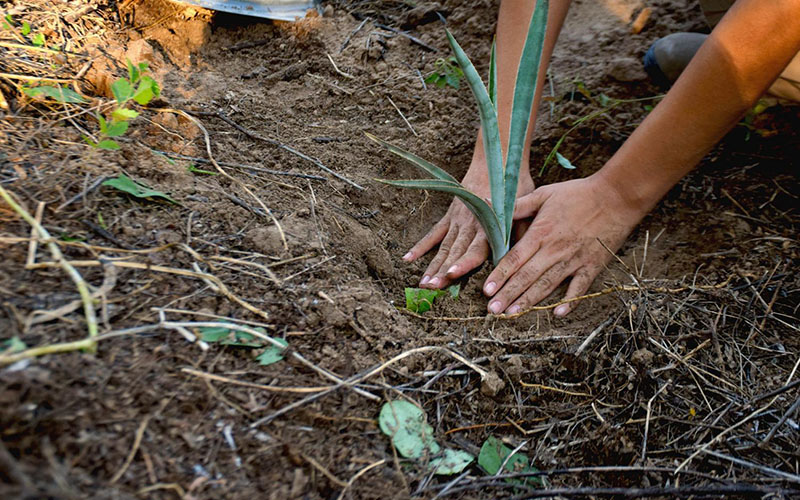
Bat Conservation International hopes to plant 1 million agave in Sonora and Arizona in the next 10 years. Nectar-feeding bats, which are prodigious pollinators of saguaros and other Sonoran Desert cactuses, depend on the succulents as they migrate across the border and back. (Photo by Kendal Blust/KJZZ)
ÁLAMOS, Sonora — Shovels in hand, dozens of volunteers peeled back layers of bright green undergrowth and drying grasses at Parque la Colorada, about 30 miles east of the Sea of Cortez. Carefully, they planted small agave “pups” one-by-one along the park’s main trail on a humid October afternoon.
It’s part of Bat Conservation International’s ambitious plan to plant 1 million of the spiky succulents in the U.S and Mexico in the next 10 years.
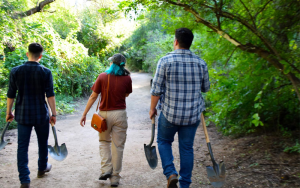
Volunteers enter Parque La Colorada in Sonora to plant agave in early October. (Photo by Kendal Blust/KJZZ)
“Reforestation is hard, difficult work,” said David Gastelum of Colectivo Sonora Silvestre in Hermosillo, which leads agave restoration efforts in Sonora. “And it’s work nobody is doing in Sonora, but it’s a real issue. We can see the shortage of agave here.”
Gastelum said the spine-tipped, blue-green agave angustifolia has an important cultural and ecological place in the Arizona-Sonora borderlands.
Sonora’s traditional alcoholic drink, bacanora, is distilled from the sugary plant. Agave also is critical for pollinators, including the nectar-feeding lesser long-nosed bat that summers in Sonora and southern Arizona, and the endangered Mexican long-nosed bat, which migrates into New Mexico and Texas.
Bats as pollinators
The lesser long-nosed bat, which recently was removed from endangered status, was the “guest species” at this year’s Jaguar Day Festival in Álamos.
While kids made bat crafts at a workshop during the festival, Catherine Bartlett and Robin Kropp with the Arizona-Sonora Desert Museum described the “bat machine.”
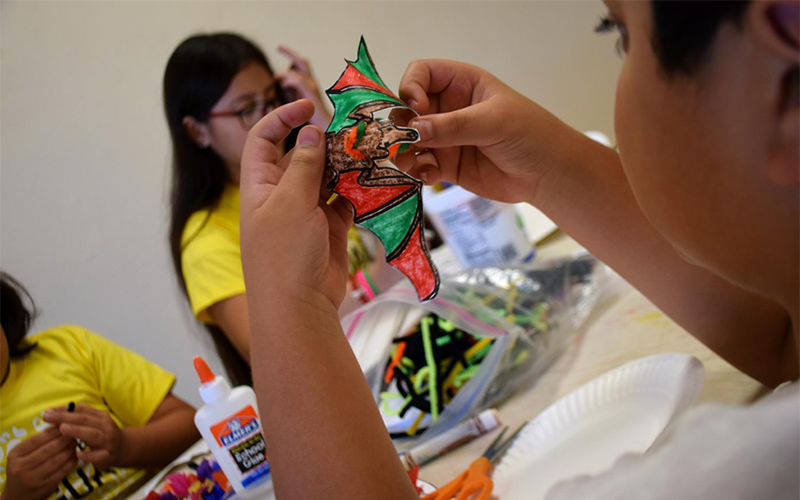
Children make bat crafts during a workshop at the Jaguar Day Festival in Álamos, Sonora, in October. (Photo by Kendal Blust/KJZZ)
“This is how a bat hears on the bat’s frequency,” Bartlett said. The machine made an echoey, scratchy noise as she rubbed her fingers together. “So that’s how they can hear like a scorpion walking along and hunting.”
Nectar-feeding bats, like the lesser long-nosed bat, are important pollinators in the Sonoran Desert.
“Well this is the cool story,’ Krupp said, “because they are pollinators of our big columnar cactus,” such as saguaros and organ pipe the bats visit during their migration north from central and southern Mexico each summer.
Most of the migrating bats are pregnant females looking for so-called maternity caves in this region before they head back south with their babies.
On their southbound journey, bats rely on agave flowers. But agave are declining.
Agave shortage
Habitat loss and climate change are some of the many reasons there’s an agave shortage.
“But the reduction in wild agave populations is mainly because of illegal harvesting,” Gastelum said.
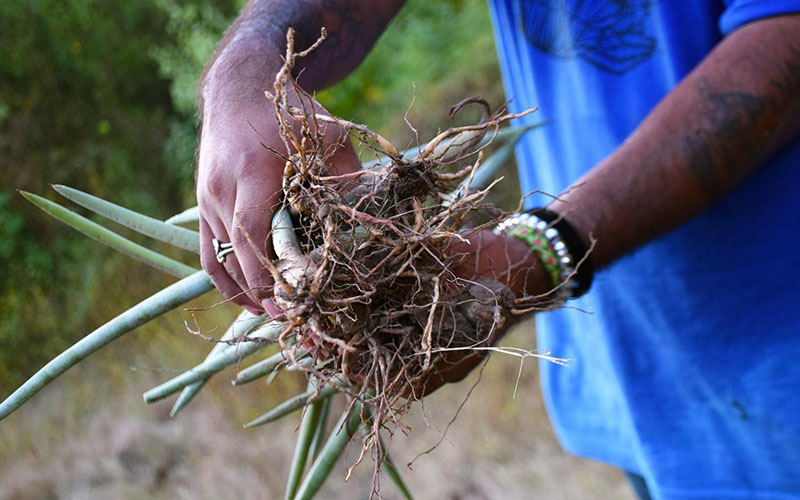
Agave angustifolia, ready to be planted. (Photo by Kendal Blust/KJZZ)
Growing demand for agave spirits in the U.S. and beyond has raised issues of agave sustainability throughout Mexico.
But unlike tequila and other mezcals, bacanora production was prohibited for 77 years, until 1992. So clandestine bacanora makers relied on unregulated harvesting of wild agave.
“When people are harvesting agaves in the wild, these aren’t agaves that have already flowered and the bats have already taken their fill of them. They’re plants that they have to get before they flower,” said Francesca Claverie, nursery manager for Borderlands Restoration Network, which works on agave restoration in Arizona and supports the Colectivo Sonora Sivlestre in Sonora.
Claverie said agave hearts, or piñas, spend years building up sugars that make delicious spirits. Those sugars are released when the agave shoots up its towering stock, which only flowers once in the plant’s lifetime. It takes years — decades for some agave species — to flower. By then, the agave is no good for bacanora.
And when agave aren’t allowed to flower, bats go hungry.
Bats, agave and bacanora
Bacanora production has been a main culprit in agave loss, but it’s also part of the solution, said Lea Ibarra, another leader of the Colectivo Sonora Silvestre.
“They are like a key in the project, the bacanora producers,” she said. “They’re already thinking about agave sustainability, and they know it’s important.”
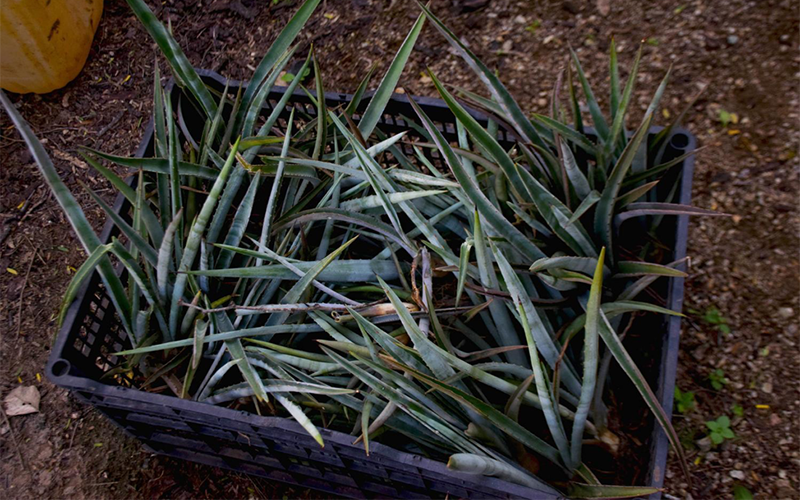
Habitat loss and climate change are among the reasons there’s an agave shortage, but illegal harvesting by mezcal producers is the main one. (Photo by Kendal Blust/KJZZ)
The collective is working with bacanora producers to allow more agave to flower.
“We get the better part of the deal anyway,” said Rodrgio Bojorquez, a bacanora producer in southern Sonora and board chairman of the company Dalumoro, which has been growing agave in Sonora since 2010.
He said bats are the agave’s best pollinators and improve the plant’s genetic diversity.
“I don’t think you can have one without the other,” Bojorquez said. “If we want to keep the bats around, we need the agave around. And if we want the agave around, we most certainly better take care of the bats.”
Volunteers in Álamos water each of the newly planted agaves – nearly 400 of them.
Colectivo Sonora Silvestre has planted almost 700 agave so far and hopes to reach 1,000 by the end of the year. In Arizona, about 2,000 seedlings have been planted as part of the project. In addition to agave angustifolia, the group is planting agave palmeri and agave parryi in Arizona and elsewhere.
That’s just a drop in the bucket compared to the goal of 1 million agave. But Valeria Cañedo of Colectivo Sonora Silvestre said the idea is to rebuild pockets of agave along the bats’ migration trail over time.
“We’re providing them the gas, the fuel they need,” Silvestre said. “It will be like way stations for them. They can stop, they can eat a little bit, they can rest, and they can continue with their travel.”
And in the long run, those well-fed bats will be the ones propagating and protecting the agaves.